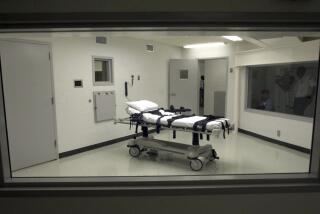Graphic How-To Program on Suicide to Air on TV in Oregon, Sparking Debate
SEATTLE â Late-night cable television in two Oregon cities this week will air a graphic how-to program for committing suicide, the latest salvo in an escalating debate over physician-assisted suicide.
The 34-minute âFinal Exitâ program, produced by Hemlock Society founder Derek Humphry, lays out the ordinary workshop hardware needed to end a life quickly and painlessly and offers advice on such practical aspects as âkeeping clear of the lawâ and âdealing with the aftermath.â
The scheduled broadcast has touched off a new debate in Oregon, which in 1997 became the first state to legalize physician-assisted suicide. Proponents of the law called the video âdangerousâ and said it reflects a growing extremism brought about by congressional efforts to outlaw legitimate doctor-aided dying.
âI think itâs injudicious, irresponsible and potentially dangerous for some people,â said Barbara Coombs Lee, head of the Compassion in Dying Federation, which led the campaign to pass the Oregon initiative.
âThere is information about how a person could die using very readily available tools and drugs, and for some people who may be mentally unbalanced or acting impulsively, that could be dangerous information,â Lee said.
But Humphry, whose 1991 book of the same name has sold more than 1 million copies in 12 languages, said his work is already widely available in nearly every major library and on audiocassette.
Programâs Timing Politically Motivated
âThere are some people who donât read books, theyâre not used to getting information out of books. People kept asking me for a more down-to-earth video version of it that they could just click in and watch,â Humphry said Monday from the office of his Junction City, Ore.-based Euthanasia Research and Guidance Organization.
Humphry said he sent the film to a wide variety of doctors, nurses and therapists before releasing it.
âPeople said, âWhat a useful tool this is for dying people, to see whether or not theyâre interested in euthanasia.â It will be the same with television. If people happen to come on this cable channel and it offends them, turn it off.â
The program will air in Eugene, home of the University of Oregon, and in nearby Springfield, which drew national attention in 1998 when Thurston High School student Kip Kinkel shot and killed his parents and two fellow students. He was sentenced in November to 112 years in prison.
There are no plans to air it in the stateâs major media markets of Portland and Salem. But the film already has received several viewer reviews, including one purchaser in Massachusetts who called it a âunique, expert, clear intro to self-deliverance.â
Humphry has been one of the nationâs best-known advocates for helping terminally ill patients end their suffering since he founded the Hemlock Society in 1980 in Santa Monica.
But the decision by the Eugene-based Cascadia Theater of Action program to air the video at 10 p.m. Wednesday and 11 p.m. Friday has a distinctly political focus, program directors said, aimed at legislation now before Congress that would impose federal sanctions on doctors who prescribe lethal drugs to their terminally ill patients.
âI strongly feel that if we are truly free, that an individual should have the right to decide when and how to end their life, and that a nonviolent death with dignity is preferable to something of the other sort,â said Cindy Noblitt, co-producer of the program, which will air on Community Television of Lane Countyâs Channel 97.
âI think itâs a central role of the media to provide complete and accurate information to the public that they may need to make those hard decisions in their lives,â Noblitt added.
The video shows Humphry talking about how he got involved in the issue in 1975 during his first wifeâs painful bout with inoperable bone cancer. He helped her end her life.
He goes on with detailed pictures and explanations of methods others might use to end their lives, including tips on drugs, plastic bags and inert gas masks. He demonstrates how to mix drugs with yogurt, applesauce or fruit preserves, and shows how the bag would be placed on his own head.
All of the information is preceded with a caution that it is intended for the helplessly and hopelessly ill, Humphry said. âThe opening remarks say this is not for depressed people, this is not for mentally ill people. If you are one of those unfortunate people, please go to a doctor or a therapist or a minister and seek help,â he said.
But Portland psychiatrist Gregory Hamilton, president of the organization that opposed Oregonâs physician-assisted suicide measure, said airing the film is âa terrible ideaâ that is likely to promote suicide as an option.
âThe suggestion of suicide works just like an advertisement. We know that commercials donât have to say âGo buy apples,â they can just say, âApples,â thatâs all it takes to influence viewers,â Hamilton said.
âDerek Humphry is not only suggesting suicide to the vulnerably ill, heâs using the power of suggestion to promote suicide as a solution to lifeâs problems to anyone viewing, whether they be an abused teenager, a depressed adult or an impressionable child.â
Hamilton pointed to a study published in the 1993 New England Journal of Medicine that looked at suicides in New York City after the initial publication of âFinal Exit.â
The study showed little change in the number of suicides, but there was a substantial increase in the number of one of the techniques recommended by Humphry, asphyxiation by plastic bag: from eight to 33.
Techniques Called âHighly Lethalâ
âOne of the problems with Derek Humphryâs promoting his suicide techniques is those techniques are highly lethal, so people donât get a second chance,â Hamilton said. âNormally, the majority of people who make a suicide attempt recover from that suicide and they change their mind, and weâre able to successfully treat them.â
To the contrary, Humphry responded to the New England researchers, a plastic bag usually takes 30 minutes and a dose of drugs, 15 minutes. âThere is no similar moratorium once the trigger has been pulled, or the jump [from a high place] made,â he said.
Underlying the debate are concerns that federal legislation to outlaw physician-assisted suicide, passed by the House last year and now pending in the Senate, is pushing assisted-suicide advocates toward extreme positions.
If the federal legislation passes, Humphry said, âit will drive hastened death and assisted suicide underground even more, and there will sadly be an even bigger demand for âFinal Exit.â â
âThatâs the irony,â Lee said. âThat Congress would disable the very moderate approach that Oregonians have taken and in the process of disabling the moderate, they really empower the extremists.â
More to Read
Sign up for Essential California
The most important California stories and recommendations in your inbox every morning.
You may occasionally receive promotional content from the Los Angeles Times.










